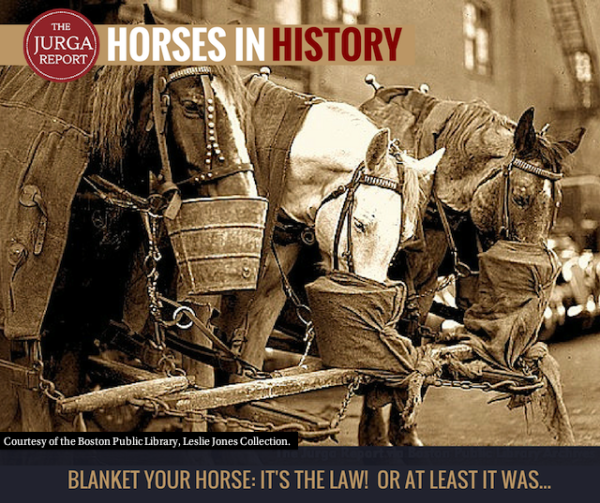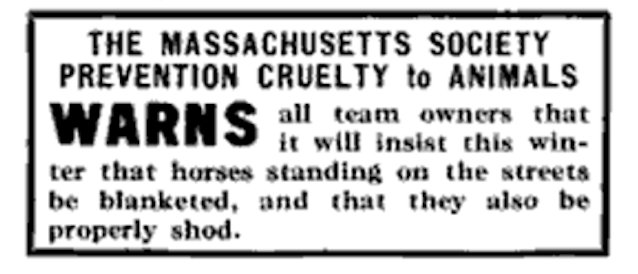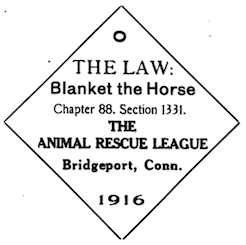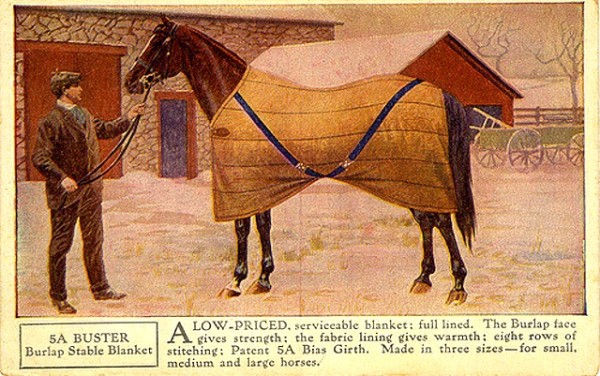
Should you blanket your horse? We could argue about that question all day. But a hundred years ago, you would not have had a choice.
Owners today have a wide selection of blanket fabrics, sizes and weights. We have electric clippers. We have stable blankets and turnout blankets and summer sheets and post-workout coolers. Owners can also choose whether or not to subject their horses to the extreme elements of winter cold, how long to leave them out, and whether or not to heat their barns.

But back in 1917, humane society activists believed that every horse should wear a blanket unless it was moving–and they convinced city governments to write horse blankets into the law. Enforcement was rigid. Fines were high.
And in some places, the laws are still on the books today.
• • • • •

Why did the horse put on a blanket?
He was a little colt…
One hundred years ago, the horses working our city streets had a hard life. Some were better treated than others. Some lived much longer than others. But any horse that ventured out onto the street was risking its life. It might slip and fall on pavement, be electrocuted by a downed wire, fall into a manhole on the street, or be beaten by its owner.
Yet these horses were on the radar of city humane society observers who were determined to improve their care and make life better and safer for all horses. They were also determined to mandate better horse care not an option: they wanted to make it the law.
In northern cities, where horses worked all winter regardless of the weather, horse blankets became the cause célèbre of horse activists during the winter months. And in most cities, their use wasn’t a sign of kindness. Drivers blanketed their horses because they were required to do it. An unblanketed horse could send a driver to jail, or force a large fine to be paid.
Cut-to-fit horse blankets were first manufactured in 1857 by the pioneering Troy Woolen Mills in Troy, New Hampshire. But those early fitted horse blankets woven on New England looms were more likely to end up on the fine harness and riding horses of wealthy Americans than on city dray horses.
Every old magazine in the archives seems to feature an advertisement for the famous Baker 5A line, and many others. The blankets required surcingles, when worn in the stable, or used giant blanket pins that are very collectible today. The ads make horses look proud to be wearing the blankets, and praise owners who make sure their horses wear stable blankets. Those horse owners weren’t worried about breaking the law.
The laws were aimed at the lowest class of horses, the urban working class. Thousands of freight, coal delivery, and other working horses clogged the streets of the cities. Their hard work was obvious; they kept the city moving. Equally obvvious was the fact that so many were poorly groomed, unclipped, badly shod, and generally neglected. The humane societies wanted to change that.
Drivers were responsible for the horses out on the street, but their welfare was the provenance of the owners, usually large corporations or livery stables that rented out a horse and wagon by the day or week.
So when the humane societies lobbied lawmakers to require horses to wear blankets, the drivers had to do the work of blanketing, unblanketing and reblanketing the horses.
Since work horses weren’t clipped in winter the way that a field hunter or a fine driving horse might be, sweat and rain clung to them in the winter while they worked. Steam often rose from their bodies as they pulled up hills.

The theory was that the sweat would and should evaporate into the air as long as the horse was expending energy. Putting a blanket on the sweating horse was designed to protect it from developing a chill while standing still, since its body produced less heat at rest. It was against the law for a blanket to be on a moving horse.
Horse blankets of past days didn’t have liners like today’s blankets. They were a major chore to wash and mend.
But the biggest problem seems to have been motivating the drivers to put the blankets on properly and remove them.
In order to put a blanket on a horse, the driver needed to get down from the seat, get the blanket out, and unfold it over the horse. When he was ready to be underway again, he had to remove the blanket and stow it away. Team drivers had to do this twice, once for each horse.
Some laws also stated how much of the horse must be covered, but they didn’t specify what the blanket should be made of or what to do if the blanket was wet., So, the same blanket might be used in wet weather as dry weather. And a still-wet blanket from the previous day might be put on a horse on a dry day.
Blankets could be shared between different horses from the same stable, leading to the spread of disease and skin irritations.
A common use for a horse blanket was for it to be laid down on the street when a horse slipped and fell on ice, in the hope it would offer some traction when he tried to rise. Since the horses wore sharp calks on their shoes, it wasn’t uncommon for holes to be ripped through a blanket as a horse scrambled to its feet, if it could.
How cold did it need to be to bring out the blankets? In Philadelphia, it was forty. In 1915 in that humane-minded city, agents of the Pennsylvania SPCA said that they placed 1,227 blankets on horses where none had been provided. They issued warnings to drivers who didn’t blanket their horses or who were driving “smooth shod” horses when calks should have been required for more secure footing.
The agents cruised Philadelphia’s streets in a society-owned car, looking for unblanketed and smooth shod horses. Three agents were in the car, which was stocked with chain overshoes, cloth slippers and blankets.

Missoula, Montana sounds like the wild west, but the zeal of the humane societies extended there, as well. Instead of covering standing horses, the law there was that no horse could be left unblanketed for more than six hours at a time. The Missoula Humane Society reported that nearly every horse in the city was blanketed and noted in 1915 that, to their delight, “the Indians are covering up their horses, using bed comforts and shawls when horse blankets are not available.”
It wasn’t just horses who were subject to blankets. An unusual law in Pennsylvania–which may still be on the books–was written when cars were very new, and scared horses to death. The law required motorists to pull over if they saw a horse approaching, and to cover the car with a blanket so it wouldn’t frighten the horse! And in 1911, one large city’s human society wrote an article in its journals about a new trend in New Zealand, where cows also needed blankets, they said.
Today, we are more circumspect about when, where and even if a horse should wear a blanket. The weather, the age of the horse, the breed of the horse, the general health of the horse, and many other factors are considered, along with the practice that if a horse is to wear a blanket throughout the winter, it should start wearing it in the fall so its coat stops growing. Some horses wear stable blankets or turnout rugs all day and all night. Others wear none at all.
Humane society agents erected signs in multiple languages reminding drivers to blanket their horses. Failing to blanket your horse could send you to jail for 25 days in the case of Buffalo, New York or incur a large fine. Buffalo claimed 100 percent compliance in 1914, perhaps because of the heavy penalties of not blanketing. A judge in Burlington, Vermont sentenced a huckster to 90 days in jail that year for not blanketing his horse.
In Kansas, horse blanketing was a state law.

An article in the Chicago Tribune that year complained that drivers had been issued blankets for their horses but were too lazy to use them. The article was especially critical of the treatment of coal delivery horses, who stop and go often. According to the report, the horses often have blankets that are doubled and draped over their rumps, giving no protection to the chest and withers.
Today, cities with carriage horse businesses still have ordinances requiring blankets on horses. In New York City, the current rule reads:
From November through April, heavy winter blankets must be available in cold weather to cover a carriage horse from crest to rump. Additionally waterproof blankets of lighter material shall always be available when it is raining and the temperature reaches 55 degrees Fahrenheit or lower.
The law does not specify what “heavy” means, that the blankets be in good repair or that the blankets be removed when the horse is underway. Shreveport, Louisiana’s carriage laws do specify that the blankets be repaired, and forbids owners from sharing blankets, or any tack, between horses.
But can we legislate kindness? We know that helmets don’t prevent head injuries unless they are properly fit and the chin strap is fastened. Horse blankets might seem to be a sign that the owner cares about the horse, but the blankets might also be hiding rain rot, protruding ribs or untreated wounds.
Who can forget the massive horse abuse raid at Spindle Farm in Amersham in England in 2008, when horses were found dead in their stalls, but wearing winter blankets?
A warm blanket is a wonderful thing for a horse who needs one. But like everything, it is one spoke of a wheel of kindness that must include many facets of care all year round, along with good nutrition and healthcare.
To look out across a city square and see blankets on all the horses on a cold winter day must have been a great victory for the humane societies, but they also knew it was the tip of an iceberg, one that we are still chipping away at today.
To learn more:








